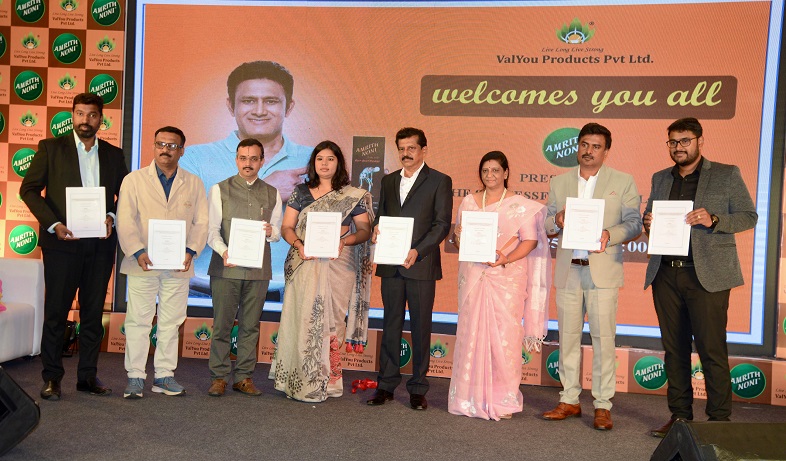
Hyderabad, India – Feb 04, 2025 – nSure Healthy Spine proudly announces the adoption of an advanced data-driven Musculoskeletal Health Technology Platform in exclusive partnership with Nordic Health Finland. The state-of-the-art biomechanically optimized exercise therapy devices for Spine, Shoulder, Hip & Knee Health will be incorporated at upcoming India’s 1st Center for Spine and Sports Health (CSSH) located at Kotak Pullela Gopichand Badminton Academy, Hyderabad, India.
As part of a strategic collaboration to introduce cutting-edge spine and sports health technology platform in India, nSure Healthy Spine has recently hosted Technology Inventors from Nordic Health, Finland – Mr. Arno Parviainen and Mrs. Sirkka Parviainen at CSSH, Hyderabad. Their visit marks a significant milestone in integrating advanced assessments, targeted muscle-strengthening training programs for Injury prevention, and preventive musculoskeletal care solutions, aimed at enhancing the performance and well-being of athletes and individuals seeking proactive health management.
With Finland being one of the top innovative health technology ecosystems, the expertise of Nordic Health leadership has become instrumental in training our team to leverage advanced technology effectively and deliver world-class care at CSSH, Hyderabad.
During the visit, Mr. Arno and Mrs. Sirkka conducted comprehensive training & educational programs for the nSure Healthy Spine team. The sessions focused on the clinical use of biomechanically optimized exercise therapy devices to ensure precise assessments and evidence-based exercise therapy programs. Throughout the training sessions, they emphasized the latest techniques in movement health, rehabilitation, and performance enhancement, to make our team remain at the forefront of spine and sports health.
Being enthusiastic about the collaboration, Mr. Arno, CEO of Nordic Health Finland and expert in movement and rehabilitation technology, stated, “The integration of this technology at nSure Healthy Spine is going to be a game-changer for spine and sports health in India. We are excited to support the team in utilizing these cutting-edge solutions and assisting athletes with injury prevention and performing better.”
Mrs. Sirkka, a specialist in preventive healthcare, added, “This technology is not just about rehabilitation but also about proactive-driven preventive spine & musculoskeletal (MSK) care. By focusing on muscle strength and functional movement, we are helping individuals prevent injuries and enhance their overall well-being.”
nSure Healthy Spine’s CEO, Naresh Kumar Pagidimarry, highlighted the long-term vision behind this collaboration, stating, “Bringing this revolutionary technology to India is a testament to our commitment to advancing spine and sports health. With the guidance of Arno and Sirkka, I am positive that our team is equipped with world-class knowledge and expertise catering the best possible care to the clients in need.”
“The visit of Nordic Health experts reinforces nSure Healthy Spine’s dedication to integrating the latest advancements in medical technology. This initiative is set to elevate Hyderabad’s standing as a hub for cutting-edge spine and sports healthcare, benefiting athletes, professionals, and individuals seeking to enhance their quality of life,” Naresh Kumar added.

 Maintaining a healthy diet is a priority for many, helping them stay energized and fit for their busy schedules. From nutritious meals to simple, effective eating habits, &TV actors including Neha Joshi (Krishna Devi Vajpayee from Atal), Smita Sable (Dhaniya from Bheema), Himani Shivpuri (Katori Amma from Happu Ki Ultan Paltan), and Vidisha Srivastava (Anita Bhabi from BhabijiGhar Par Hai) share their approach to mindful eating and go-to healthy food choices. Neha Joshi aka Krishna Devi Vajpayee shares, “I focus on wholesome, light meals that keep me energized through the day. My breakfast usually includes a smoothie made with spinach, banana, and almond milk—it’s quick, tasty, and packed with nutrients. For lunch, I love khichdi made with millet and seasonal vegetables. It’s simple, comforting, and easy on the stomach. To stay refreshed, I sip on herbal teas like chamomile or mint, which are great for unwinding during hectic shoots.” Smita Sable aka Dhaniyaadds, “My diet is all about balance and nutrition. I make sure to include proteins like paneer, lentils, or eggs in my meals for muscle strength and energy. I enjoy quinoa salads with fresh greens, nuts, and tangy dressings for lunch—they’re light yet filling. For snacks, I rely on roasted chickpeas or almonds, which are nutritious and perfect for keeping hunger at bay during long shoots.”
Maintaining a healthy diet is a priority for many, helping them stay energized and fit for their busy schedules. From nutritious meals to simple, effective eating habits, &TV actors including Neha Joshi (Krishna Devi Vajpayee from Atal), Smita Sable (Dhaniya from Bheema), Himani Shivpuri (Katori Amma from Happu Ki Ultan Paltan), and Vidisha Srivastava (Anita Bhabi from BhabijiGhar Par Hai) share their approach to mindful eating and go-to healthy food choices. Neha Joshi aka Krishna Devi Vajpayee shares, “I focus on wholesome, light meals that keep me energized through the day. My breakfast usually includes a smoothie made with spinach, banana, and almond milk—it’s quick, tasty, and packed with nutrients. For lunch, I love khichdi made with millet and seasonal vegetables. It’s simple, comforting, and easy on the stomach. To stay refreshed, I sip on herbal teas like chamomile or mint, which are great for unwinding during hectic shoots.” Smita Sable aka Dhaniyaadds, “My diet is all about balance and nutrition. I make sure to include proteins like paneer, lentils, or eggs in my meals for muscle strength and energy. I enjoy quinoa salads with fresh greens, nuts, and tangy dressings for lunch—they’re light yet filling. For snacks, I rely on roasted chickpeas or almonds, which are nutritious and perfect for keeping hunger at bay during long shoots.”




